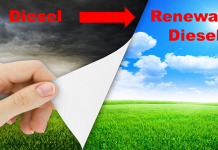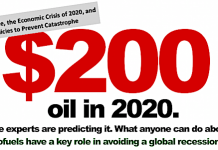Charles Morand
Peak Oil is a term that has become common currency in energy debates in last three years, due in large part to the spectacular rise in the price of crude between 2005 and the end of 2008. But what does Peak Oil actually mean and, more importantly, what do I mean when I use it in my articles?
In the purest and original sense of the term, Peak Oil refers to the point in time at which the rate of oil production (as measured, for instance, in barrels per day) peaks. This peak, according to the original theory, is then followed by a rapid and irreversible decline as attempts to extract more oil out of the ground run into the absolute geological limits of the resource. Wikipedia, as always, does a great job of explaining the theory of Peak Oil and provides a wealth of resources for those who would like to expand their knowledge further.
I do, on occasion, refer to Peak Oil in my articles, including one I wrote last week where I claimed that Peak Oil would be a powerful driver of gasoline prices in the next few years. Given how contentious this theory is, I wanted to clarify where I stood on it and how readers should interpret what I mean when they see those two words side-by-side in my posts.
Are we about to run into the absolute geological limits of oil in a way that won’t allow us to increase production going forward? I don’t know and I have nowhere near the appropriate level of knowledge to truly judge the data I see on this weekly. And frankly I don’t particularly care; humanity will hit that peak at one point or another and the exact timing is of very little relevance to me.
What is far more relevant is the price point (and time) at which we hit the economic – rather than the geological – peak: let’s call that Effective Peak Oil (EPO). EPO occurs where the marginal barrel of oil, which sets the price for all barrels of oil in the market, is so expensive that: (1) it triggers a process whereby governments, people and firms search for and find substitutes in a way that alters the structure of the economy and demand for oil forever and; (2) in the process, it also triggers a substantial economic shock. Does EPO look like a nice, smooth bell-shaped curve? Probably not, or at least not when plotted on a timescale relevant to most human beings (i.e. 60 to 90 years).
In the following interview he gave on CNBC last week (thanks to the Infectious Greed blog), Jeff Rubin, former Chief Economist at CIBC World Markets and author of the new book Why Your World Is About To Get A Whole Lot Smaller, sums up my thinking on this issue better than I ever could. His most memorable quote: “What we are running out of is oil we can afford to burn.”
DISCLOSURE: None







Have I been the only one to notice the urban sprawl caused by cheap gas? The adjustment Jeff Rubin talks about is going to be rough to say the least. Much turmoil I do see.
Agreed Jock. When I speak of substitutes in my post I mean not only actual substitutes to oil, but also entirely new modes of economic and social organization.
This can mean a whole host of things, including a reversal of suburbanization. The households already established in the burbs and that don’t have an alternative to commuting (e.g. work from home) will see their disposable wealth eroded in substantial ways by rising gasoline prices.
The potential enormity of this problem is matched only by our policy-makers shortsightedness in their refusal to do anything meaningful about it. Luckily, as investors, we can make money from spotting this trend now while a majority of people still have their heads in the tar sands.
In all likelihood “EPO” will be synonymous, practically speaking, with the peak in conventional oil. (i.e. the peak in crude oil, not including tar-sands, bio-fuels, etc.) Almost by definition, non-conventional sources are more expensive to produce. Therefore talking about “economic” instead of “geologic” peak oil is arguably a mere semantic game. The reality is likely that they are one and the same, or at least that the difference between the two is of little interest to non-experts. Indeed, one of the main messages of those who have raised peak-oil awareness is that economists have very mistakenly ignored the relationship of the economy to the natural world. This post seems to attempt to gloss over that interplay rather than acknowledge its importance.
BTW, I don’t think that it is an inherent part of the “original” peak oil theory (Hubbert’s?) that oil production decline be “rapid”. Irreversibility is the more essential point.
Jagged Ben:
When I speak of EPO I speak of all fossil-derived oil, including tar sands and offshore deposits. Biofuels do not count toward this and belong in the alternatives category.
As I said in the post, I can’t say for sure whether EPO and geological Peak Oil are synonymous. What I do know is that much of the incremental oil that’s currently being discovered and brought into production comes from non-conventional resources and carries a high price tag. As to whether or not there are enough of these incremental reserves out there to keep us on a production uptrend I don’t know.
The idea that the difference between geological peak oil and EPO is of little interest to non-experts is exactly what I am trying to convey and I never suggested otherwise.
In terms of the interplay between the economy, the natural world and economists, that really was not the purpose of this post; the purpose of this post was to inform my readers of where I stood on Peak Oil. That discussion is for another post.
Finally, in terms of the pace of decline in production, the Hubbert Curve is very steeply slopped, suggesting to me that the decline is rapid, at least in theory. However, you are right – irreversibility the most important component of the theory.
Coming from South Africa I am aware of Sasol (oil from coal) technology. How do you see this play in the peak oil argument?
Thanks.
Brent:
I did a bit of research into coal gasification some years ago but I can’t say that I’m an expert.
It is certainly an interesting technology but I question how much it can really do to address this, especially at the global level. If the economics were tremendously compelling, we would probably be in the midst of a coal-to-liquid boom right now, and we’re not….at least not in the US (and we have the coal reserves to go down that road if we want to).
China is going very hard after it because of their large coal reserves, and I know that SA used it to overcome their liquid fuel issue during the embargo.
But I’m really not sure how much of a difference it can really make to global oil prices (which is what I am concerned about with EPO). If you have any insight I’d love to know more.
Of course the other major issue is the carbon-intensity of that process, which could make it a no-go in places where carbon is priced.
As for Sasol specifically, I have definitely read some positive things about it based on its technological leadership in this realm.
WRT Sasol & CTL:
CTL technology was originally placed in high volume use by Germany during WWII when the Allies cut their fuel supply. Sasol in SA improved upon the original Fischer-Tropsch process. There are now several variations on the technology. You might also look into Headwaters and Rentech.
Carbon intensity is definitely an issue. Some estimates range as high as 2x more than gasoline from earth to wheels.
Another issue is water use. Estimates range from 1 to 7 gallons of water use per gallon of oil produced.
CTL facilities also use substantial quantities of electricity.
CTL facilities appear to be economic with oil priced above $70/bbl. But this is unclear due in part to the recent volatility of coal pricing and the dramatic increase in cost to construct these facilities.
Possibly one of the biggest issues is economic life span of such a project. The recent dramatic reduction in the estimated US coal reserves provides approximately a 100-125 year supply at present consumption rates. Previously this was generally accepted as 250+ years. Widespread use of CTL would obviously impact the life of these reserves significantly.
Further, coal reserves are typically reported in tons. I believe this is misleading. There is a dramatic difference in coal quality. Powder River brown coal can provide 8800 Btu versus 13000 from Appalachian coal. The US hit peak production of its best coal years ago. Using coal for CTL will not only increase speed at which we exhaust coal. Since we would be increasing our use of low rank coal, reserves would deteriorate even quicker.
Conceptually, with a 100 year supply at present rates and given the preceding issues, with an aggressive pursuit of CTL we could hit peak coal in roughly 25 to 50 years.
Combined with concerns about cap and trade, makes CTL appear less than attractive other than as a limited “niche” energy supply in the US.
Thanks for the useful comment Mike.